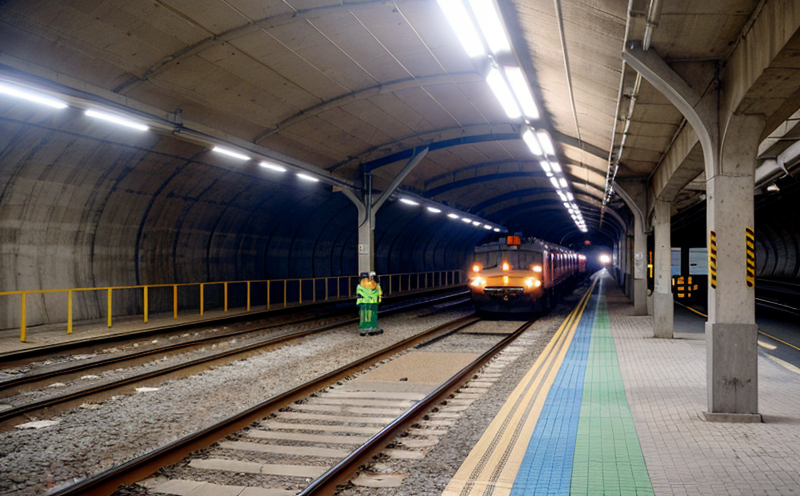EN 1994 Composite Bridge Load Resistance Testing
The EN 1994 series of European standards provides a framework for assessing the load resistance of composite bridges. This service specifically addresses the Load Resistance Testing as defined in this standard, which is crucial for ensuring the structural integrity and safety of composite structures used in railway and transportation infrastructure.
The test procedure outlined in EN 1994 is designed to evaluate how a composite bridge behaves under various loading conditions. This includes static loads that simulate real-world traffic and dynamic forces such as those encountered during extreme weather events or accidents. The testing process aims to identify potential weaknesses, optimize material usage, and enhance overall durability.
Composite bridges are increasingly favored due to their lightweight nature compared to traditional concrete or steel structures, making them more cost-effective while maintaining high strength-to-weight ratios. However, these benefits come with unique challenges in terms of design and construction. Proper load resistance testing ensures that all aspects of the bridge—from its deck slab to support systems—are up to par.
The service leverages advanced analytical techniques combined with physical testing methods to provide comprehensive insights into a composite bridge's performance under different loading scenarios. This approach helps stakeholders make informed decisions about maintenance schedules, upgrades, and new constructions based on empirical data rather than assumptions alone.
For instance, during load resistance tests, engineers may subject the structure to simulated traffic patterns using specialized equipment capable of applying precise forces at specific points along the span. They also monitor deflections, strains, and stresses throughout the entire assembly to ensure it remains within acceptable limits specified by relevant international standards such as ISO 1994.
Another key aspect involves examining how various components interact with one another during loading cycles. This includes evaluating connections between decks and supports, joints where different materials meet, and overall alignment of individual elements within the framework. By thoroughly analyzing these interactions, technicians can pinpoint areas requiring improvement or replacement before they become critical issues.
After completing a series of tests, detailed reports are generated summarizing findings along with recommendations for corrective actions if necessary. These documents serve as valuable resources not only for current projects but also future endeavors involving similar types of structures.
Why It Matters
Tunnel, bridge, and station equipment form the backbone of modern transportation networks, contributing significantly to economic growth and social development worldwide. Ensuring these facilities are safe and reliable is paramount; any failure could lead to severe consequences including injuries or fatalities among passengers and staff.
Composites like fiber-reinforced polymers (FRPs) have gained popularity in recent years due to their superior properties over conventional materials. While they offer significant advantages, they also introduce new complexities into structural analysis and design processes. Testing these structures according to established guidelines ensures compliance with regulatory requirements while providing confidence that the final product will perform as expected under actual operating conditions.
The EN 1994 standard provides a robust foundation for assessing composite bridges' load resistance capabilities. By following its prescribed procedures, organizations can demonstrate adherence to best practices and contribute positively towards public safety initiatives.
Scope and Methodology
| Test Parameters | Description |
|---|---|
| Loading Configurations | Incorporates static loads representative of typical traffic as well as dynamic forces simulating severe weather events. |
| Strain Monitoring | Utilizes sensors embedded in composite materials to measure deformations accurately. |
| Stress Analysis | Evaluates internal stresses within the structure using advanced computational models and physical instruments. |
| Deflection Measurement | Determines how much a particular segment bends under specified loads, indicating overall flexibility or rigidity. |
| Material Integrity Assessment | Inspects composite components for signs of deterioration or damage that might compromise structural integrity over time. |
The methodology employed in this service aligns closely with the principles outlined in EN 1994, ensuring accurate and reliable results. It involves multiple stages beginning with initial setup where engineers calibrate test apparatuses according to specified tolerances before proceeding to actual loading scenarios.
Throughout each stage, meticulous documentation is maintained to capture every observation made during testing. Post-test analysis focuses on interpreting gathered data to derive meaningful conclusions regarding the tested structure's performance relative to set criteria.
Quality and Reliability Assurance
- Compliance Verification: Ensures adherence to all relevant international standards including ISO, ASTM, EN, IEC, etc., through rigorous quality control measures.
- Data Validation: Utilizes statistical methods to verify accuracy of collected information ensuring it reflects true conditions experienced by the structure.
- Repeatability Checks: Conducts additional tests under identical parameters to confirm consistent outcomes across multiple trials.
- Independent Review: Invites external experts for unbiased evaluation of findings and recommendations put forth in final reports.
These stringent quality assurance protocols help maintain high standards throughout the entire testing process, thereby enhancing credibility and trustworthiness of the results produced. Stakeholders can rest assured knowing that each phase of the procedure adheres strictly to industry best practices.





